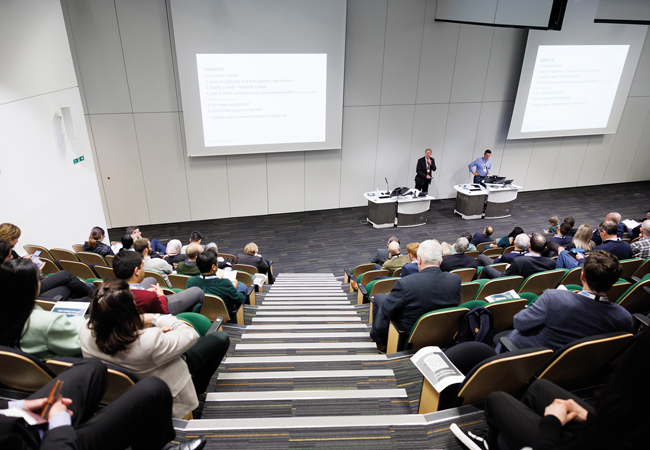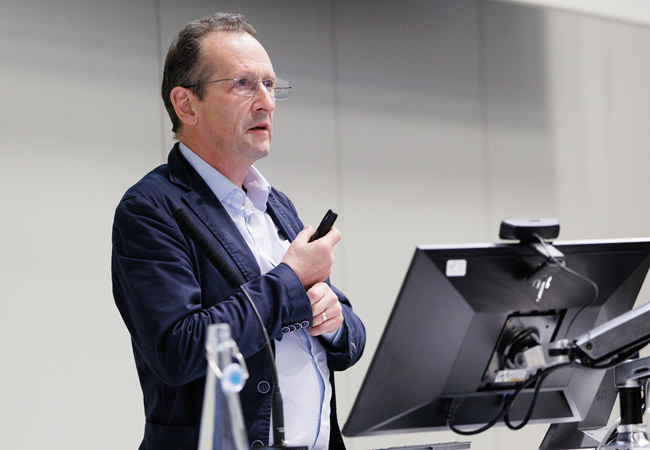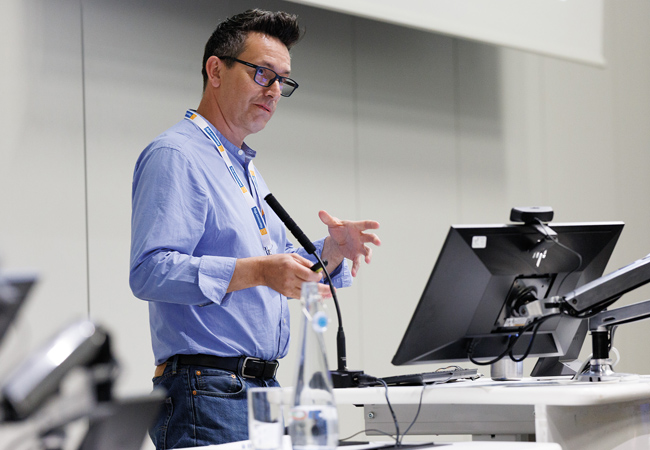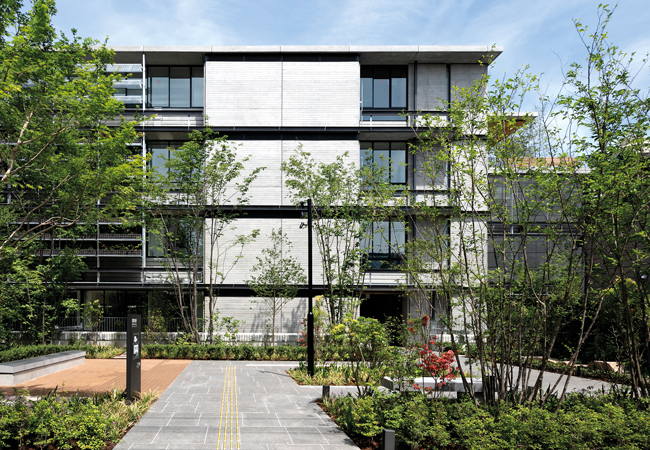
President-elect Adrian Catchpole addresses the Technical Symposium
A blueprint for retrofitting net zero housing and the influence of culture on building performance were two of the memorable presentations on the final day of the CIBSE Technical Symposium at the University of Strathclyde in Glasgow.
Chris Twinn FCIBSE from Twinn Sustainability Innovation outlined LETI’s proposed utilitarian approach to mass domestic retrofit in the final presentation of the symposium entitled ‘Home energy retrofit: LETI researches a new paradigm’.
LETI is proposing a new minimum standard for domestic retrofit and Twinn set out to give an outline of what the new standard is, the systems it includes and the likely costs.
He said the new standard is targeting halving heat demand to 65kWh·m-2 for 65% less cost based on a seven-day retrofit. Low-tech solutions were used, said Twinn, as technologies such as hydrogen were unproven. He said the LETI team had found an interesting sweet spot, which is ‘if you do just enough to improve the fabric performance, you do not have to touch the existing emitter system’.
In developing the solution, Twinn said the team made an early decision not to insulate the front façade ‘because that is high cost and hits you in the heritage sectors’.

Chris Twinn
Other fabric improvements included the windows: ‘We identified £45,000 of the £65,000 cost of a deep retrofit being windows replacement.’
Existing gas combi boilers can be replaced with a heat battery, incorporating phase change materials, he said. ‘All the pipes are already there and the existing flue hole enables the pipes to pass through the wall to a monobloc air source heat pump (ASHP) typically of around 4kW capacity.’
If you do just enough to improve the fabric performance, you do not have to touch the existing emitter system – Chris Twinn
Another early decision was the inclusion of a decentralised mechanical ventilation with heat recovery (MVHR) because ‘this allows high airtightness and reduces the issues of thermal bridging and picks up a lot more moisture with preheated air than trickle vents would do’. He said the team was looking at off-the-shelf units from China for about £400 as opposed to ‘the gold standard’ MVHR available in the UK.
Twinn said that to avoid ductwork having to be installed below the first floor, the standard was looking at using surface-mounted ductwork.

Robert Prewett
Using heat pumps and halving the domestic heating demand would ‘knock a quarter of the capacity needed in the grid’, which, he said, ‘should motivate the electricity industry to invest in housing to reduce the investment needed in the grid’.
The document would be available soon as a free download on the LETI website www.leti.uk, he added.
The transformation of existing housing stock also featured in a presentation ‘Victorian towards net zero’ by Robert Prewett, of Prewett Bizley Architects.
This was a case study on the retrofit of an upmarket, end-of-terrace London property. The key elements the retrofit had to address were large heat losses through uninsulated walls and sash windows.
Prewett Bizley Architects’ solution included: insulating plaster for the walls; external blinds on the dormer windows; roof-top ASHP; underfloor heating; evacuated glass in sash windows and heat recovery ventilation, including extract from a cupboard where clothes can be dried.
The scheme also includes four fan coil units in the ceilings to provide summer cooling using an ASHP running in reverse. Monitoring revealed an 80% reduction in energy use.
Culture clash

Ashley Bateson
Ashley Bateson FCIBSE, sustainability director at Hoare Lea, provided a thought-provoking presentation on the influence of culture in sustainable building design. He compared the cultural values in the UK with other European nations and then looked at sustainability across the continent.
The premise of his presentation was that cultural values influence people’s perspective on protecting the environment, which is important in understanding why sustainability strategies may or may not work.
Bateson started his presentation with a chart that ranked countries using sustainable building indicators. This showed Scandinavian countries and the Netherlands performing best, followed by Austria and Germany and then the UK and France.
He showed a chart of adult numeracy for the same countries that mirrored the sustainability chart. ‘Does this mean that if you increase the numeracy of the population, they would use less energy?’ he asked.
Bateson showed a plot of permitted air leakage rates for the same countries and a chart showing mandated sound insulation between dwellings. These also mirrored the sustainable building indicators chart with Scandinavian countries performing best and the UK towards the bottom of the ranking.
A plot of fuel poverty provided another perspective. This showed the UK with the worst fuel poverty in Europe for the size of the economy. Bateson said it was interesting that the UK’s policy response to rising energy prices is giving money to energy companies to continue profligate use of energy while other European countries focused on demand reduction.
A European study on eco-labels demonstrated that the UK population had the lowest awareness of what an eco-label looks like, and that UK purchasing decisions are based on price. In countries with a better sustainability performance, price was seen as less important.

Hattie Thompson
Bateson also compared the proportion of engineering degrees in different cultures, trust in professionals, numbers of researchers per million people, and a comparison of collectivist and individualist values, all of which showed a correlation to the initial sustainability chart.
His final comparison was the influence of female inclusion in policy-making. ‘Evidence from the UN is that if planning decision-making is more inclusive it will have more sustainable outcomes,’ Bateson said.
Also from Hoare Lea, Hattie Thompson set out to explore why the term sustainability in planning and design documents referred to environmental objectives rather than social aspects of sustainability
Thompson defined inclusive design as making places accessible to everyone regardless of age, ability or circumstance.
Her research included a keyword search and an analysis of four different design guides: National design guide; National planning policy framework; RIBA sustainable outcomes guide; and the Plymouth and SW Devon joint local plan.
This showed that the term sustainability almost always referred to environmental objectives rather than social aspects. She said: ‘The main message was that environmental sustainability was the main priority and disabled access was not well recognised in these documents.’
The planning system does not incorporate inclusive design objectives, she added, which are left to Building Control who rely on Part M to provide a minimal, compliance-led approach and not best practice.
‘If a building is not accessible it is not sustainable because it will only have to be changed in the future,’ she said.
Whats happening over the pond

Ben Skeleton
Ben Skelton, president of Chicago-based Cyclone Energy Group, gave a presentation on Decarbonisation of industrial logistics centres, which also provided an interesting overview on some of the innovative low carbon initiatives currently being introduced in the United States.
Industrial logistics buildings are the second biggest real estate market in the US, after construction of public storage facilities. In the past, these buildings have had a significant carbon impact from the operational carbon from their heating, lighting and sometimes cooling, and also from their embodied carbon because in the US most of these buildings are constructed with a precast concrete fabric and incorporate concrete floors up to 500mm thick.
Skelton said that things were now starting to change. ‘Five years ago decarbonisation was not a word in the US, but in the last two years things have changed dramatically, driven by corporations rather than state energy policy [individual States adopt their own decarbonisation policies], so that we’re now talking about low energy buildings and zero carbon buildings.’
The International Energy Conservation Code establishes minimum requirements for energy efficient buildings using prescriptive and performance-related provisions for these buildings. Skelton said that the approach when developing the HVAC strategy was ‘keep it simple’, but he warned that this was going to get harder as HVAC systems are electrified.
Most logistics centres are heat only, unless they are for perishable products in which case they will use a CO2-based system. Currently heat is provided by rooftop units that in southern states incorporate electric coils or gas heaters in northern states, but Skelton says there is ‘a big shift’ to air source heat pumps.
He said that ASHPs were fine in climates below the middle of the country because ‘ambient is not that cold’. However, in Chicago, where the outside base design temperature is -13oC, he said ASHP performance drops off significantly at -6oC and that ‘the only way to make up that capacity is with another heat source such as electric heat or fossil fuel for the very short period’.
Skelton said that one of the biggest opportunities for logistics centres was the use of the roof for solar power generation.
‘The average project we work on has between 75,000m2 and
90,000m2 of roof area, which provides a tremendous amount of generation capacity’.
One of the major challenges is that logistics centres have to be designed for the future electrification of fleet vehicles, which he said ‘can be really hard to do because some of these buildings have 300 to 400 loading docks’.
He said that because the infrastructure does not currently exist for heavy vehicle charging, this will provide a huge opportunity for industrial logistics centres to become charging stations because they have the power source. ‘They are everywhere, they are located around interstate motorways, where most transportation is occurring, and they are easily accessible,’ he says.
Skelton says what will drive the change ‘is the increased call for the public disclosure of energy information’. He explained that in March the city of Denver had adopted the Energise Denver Initiative – see below.
Based on this initiative, he said that Cyclone had modelled the energy use intensity of what Cyclone typically design in Denver and what it will need to be in the future.
He said the shortfall could result in an annual fine of £600,000. ’Fines will start to drive people’s thinking about upfront costs because this initiative will change payback periods significantly,’ he said. Chicago is going to adopt a similar policy and Skelton said the initiative ‘will spread very quickly throughout the US’.
- The 2023 CIBSE ASHRAE Technical Symposium papers will be available on the website by 15 June at www.cibse.org/symposiumpapers.
- For coverage of day one of the symposium see the article
‘Heat networking opportunities’, CIBSE Journal, May 2023
Denvers decarbonisation drive
Denver has committed to eliminating greenhouse gas emissions in all new buildings and homes by 2030 in all existing buildings and homes by 2040. The initiative applies to all buildings 2,300m2 and larger. It uses EUI as a measure of a building’s total energy usage.
Targets are set at 85/15th percentile for all covered buildings. Interim targets are set for 2024 and 2027. All buildings must maintain the interim targets each subsequent year and the final energy performance target indefinitely. On-site solar power generation will be fully credited towards the electricity portion of the total energy use, lowering the building’s EUI.






